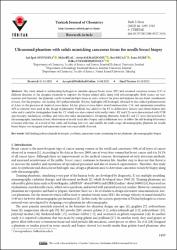| dc.contributor.author | Yayla, Işık İpek Avcı | |
| dc.contributor.author | Bilal, Melis | |
| dc.contributor.author | Salmaslıoğlu, Artur | |
| dc.contributor.author | Erçağ, Erol | |
| dc.contributor.author | Sezer, Esma | |
| dc.contributor.author | Ustamehmetoğlu, Belkıs | |
| dc.date.accessioned | 2023-05-06T17:20:49Z | |
| dc.date.available | 2023-05-06T17:20:49Z | |
| dc.date.issued | 2022 | |
| dc.identifier.issn | 1300-0527 | |
| dc.identifier.uri | https://doi.org/10.55730/1300-0527.3454 | |
| dc.identifier.uri | https://hdl.handle.net/20.500.11776/11963 | |
| dc.description.abstract | This study aimed at synthesizing hydrogels to simulate opaque breast tissue (BT) and coloured cancerous tissues (CT) at different densities of the designed phantom to improve the biopsy-related skills along with ultrasonography. Both tissues are tear-resistant and therefore, the phantom can be trained multiple times in order to lower the price and improve the eye-hand coordination of users. For this purpose, self-healing (SH) polyacrylamide (PAAm) hydrogels (SH hydrogel) obtained by free-radical polymerization of AAm, in the presence of chemical cross-linker, BAAm, physical cross-linker stearyl methacrylate, C18, and ammonium persulfate APS as initiator were used in the design of phantoms. Psyllium was added to the BT to differentiate density and obtain human skin color and it could be distinguished from the CT which was also colored with methyl violet. BT and CTs were characterized with FTIR spectroscopy, mechanical, swelling, and refractive index measurements. Designing phantoms from BT and CT were characterized by ultrasonography, mechanical tests, observation of needle track after biopsy, and stabilization tests to follow the self-healing behaviours of tissues with time. As a result of this study, self-healing, low-cost, and suitable for multi-usage ultrasonographic phantom for needle breast biopsy was designed and cancerous tissue was successfully detected. | en_US |
| dc.description.sponsorship | [214S357] | en_US |
| dc.description.sponsorship | Acknowledgements We thank T?B?TAK, which supported our work with project number of 214S357. Many thanks to Dentist Dr. Hayri Bingeli for their help with molding the hydrogels. | en_US |
| dc.language.iso | eng | en_US |
| dc.publisher | Scientific And Technological Research Council Turkey | en_US |
| dc.identifier.doi | 10.55730/1300-0527.3454 | |
| dc.rights | info:eu-repo/semantics/openAccess | en_US |
| dc.subject | Self-healing polyacrylamide hydrogels | en_US |
| dc.subject | psyllium | en_US |
| dc.subject | cancerous tissue containing breast phantom | en_US |
| dc.subject | ultrasonographic biopsy | en_US |
| dc.subject | Self-Healing Hydrogels | en_US |
| dc.subject | Tough | en_US |
| dc.subject | Behavior | en_US |
| dc.subject | Gelatin | en_US |
| dc.subject | Gel | en_US |
| dc.title | Ultrasound phantom with solids mimicking cancerous tissue for needle breast biopsy | en_US |
| dc.type | article | en_US |
| dc.relation.ispartof | Turkish Journal Of Chemistry | en_US |
| dc.department | Fakülteler, Fen Edebiyat Fakültesi, Kimya Bölümü | en_US |
| dc.identifier.volume | 46 | en_US |
| dc.identifier.issue | 5 | en_US |
| dc.identifier.startpage | 1493 | en_US |
| dc.identifier.endpage | 1503 | en_US |
| dc.institutionauthor | Erçağ, Erol | |
| dc.relation.publicationcategory | Makale - Uluslararası Hakemli Dergi - Kurum Öğretim Elemanı | en_US |
| dc.identifier.wos | WOS:000876350600012 | en_US |
| dc.identifier.scopus | 2-s2.0-85143146734 | en_US |
| dc.identifier.trdizinid | 1142219 | en_US |



















